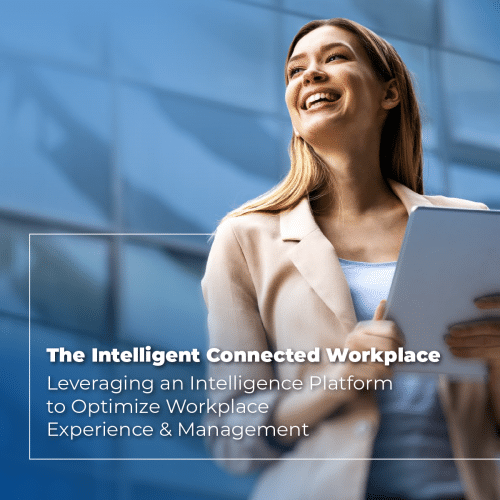You have heard of the “smart workplace” but this concept is unclear or completely foreign to you? You would like to implement a strategy to improve the working environment at your company? Here are some tips to help you in your approach!
Far from being an abstract notion with no real basis, the smart workplace is one of the terms that have been introduced to designate new ways of organizing work, linked to the development of telecommuting and the hybrid office.
The smart workplace, a component of the modern workplace
The smart workplace concept is part of the more global notion of the “modern workplace.”
What is the modern workplace?
The modern workplace is a dynamic and supportive environment that aims to make the most of human capital in a quickly evolving world of work. It responds to a global trend toward increased mobility and flexibility. Already present before the pandemic, this trend is accelerating and has opened the way to new hybrid modes of work.
The notion of the modern workplace includes the concepts of the hybrid workplace (a work ecosystem that offers a mix of on-site and remote work), the digital workplace (which encompasses all the digital technologies people use to get work done in today’s workplace), the virtual workplace (where employees can collaborate regardless of where they are located) and, above all, the smart workplace.
A smart workplace puts technology to work for employees
Generally speaking, a smart workplace makes use of technology to connect and engage employees with their work environment, whatever it may be (on-site, remote…). It aims to adapt workspaces to new ways of working by using technology and in particular digital tools.
Read also: What are the key advantages of space management software?
Intelligent workplace: challenges and solutions
The main challenge of the smart workplace is to effectively adapt the work environment to new practices in order to meet employees’ expectations while improving productivity.
Telework and smart workplace
The main evolution of the last few years, which concerns a very large number of companies, is the considerable development of telework following the Covid-19 crisis. At first, companies quickly reacted to the pandemic by allowing employees to work from home, giving them remote access to critical services needed to do their jobs.
However, the smart workplace allows organizations to go further; plan long-term strategies and adapt and optimize the functioning of the workplace. For example, it has been observed that telecommuting isolates employees and leads to less interaction with colleagues.
The smart workplace responds to this observation by offering employees a global digital work environment, so that they can connect to the “office” and to colleagues easily and quickly, by various means such as chat, phone, or video calls.

The office as a collaborative space
“When you go to work, you go to collaborate”: this sums up one of the main evolutions of the last few years. With the development of telecommuting, the office has become a space where employees not only go to get work done but also to collaborate with their colleagues. For knowledge workers, this is an essential activity, as collaboration fuels ideas for problem-solving and innovation. Workspaces must therefore be perfectly adapted to collaborative work and exchanges.
For example, it is important that meeting rooms are always available when employees need them. Experience shows that meeting rooms are often considered occupied when they are actually unused. Smart workplace tools can address this challenge, not only through room reservation services but also by providing real-time room availability, for example through sensors that can detect whether a room is actually occupied.
How to implement a smart workplace with digital tools?
To transform a traditional office into a smart workplace, there is a need for software designed for this purpose.
Applying intelligent workplace principles to the physical office
It is in the physical workspaces, i.e. the company’s offices, that the implementation of smart workplace principles can be the most complicated. It’s a matter of designing and fitting out places for activity-based working: brainstorming and huddle rooms, phone booths and concentration spaces, relaxation and lounge areas, etc. It is also a question of managing the reservation of rooms, cleaning, and maintenance of spaces without disturbing their users.
Read also: How can you improve your company’s workplace management?
Spacewell, smart workplace software designed for the hybrid era
Implementing smart workplace principles in physical offices is not possible without a dedicated application. Spacewell’s smart Workplace platform has been specifically designed to enable companies to easily achieve this goal, by combining real-time data, efficient workflows, and employee-facing functionality.

Some key features:
- Easy booking of rooms and workstations
- Access to real-time floor plans on mobile devices
- Locating colleagues to be in proximity of your team
- Monitoring of comfort and indoor air quality
- Occupancy tracking and visualization
- Space analytics and space-saving simulations
- Effective responses to service requests
In addition, Spacewell’s smart workplace app is intuitive to facilitate interaction with the office environment, customizable, for true user comfort, and flexible.
The pandemic has shown how crucial it is to offer a coherent work environment adapted to the needs of knowledge workers. The way people work has changed dramatically and a totally sedentary way of working is now outdated.
Making your office smart allows you to rethink the employee experience and adapt to this digital transformation while reaping several benefits, such as better employee engagement and productivity.
Spacewell Workplace is the perfect tool to achieve these goals!







